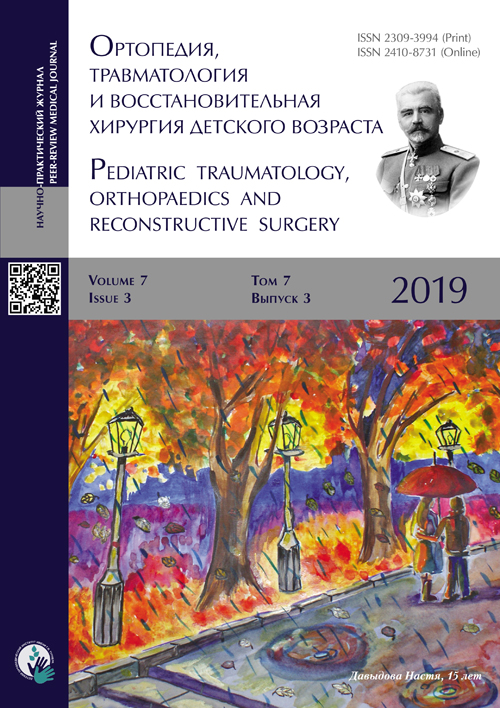卷 7, 编号 3 (2019)
- 年: 2019
- ##issue.datePublished##: 02.10.2019
- 文章: 11
- URL: https://journals.eco-vector.com/turner/issue/view/802
- DOI: https://doi.org/10.17816/PTORS73
Original Study Article
小儿重度特发性脊柱后凸侧弯的手术矫正研究
摘要
背景:经椎弓根金属混合结构的应用,已取得显著效果。但在重度特发性脊柱侧弯手术过程中,这些脊柱系统的植入有诸多限制。外科治疗策略考虑的不仅仅是术中矫正操作的表现,还有主要畸形椎弓顶部的活动度。松动性椎间盘切除术一般用于特发性脊柱侧弯患者顶椎。经椎弓根截骨术、Ponte截骨术、Smith-Petersen截骨术最常用于治疗神经肌肉性脊柱侧弯和以脊柱后凸为主的脊柱畸形。但对于小儿“被忽视”的脊柱疾病和特发性脊柱侧弯,手术矫正依然存在问题。
目的:本研究旨在对小儿极重度特发性右侧胸椎侧弯的两种脊柱畸形矫正方法进行对比分析,即单用经椎弓根脊柱系统和联用顶椎楔形截骨术。
材料和方法:对20例15至17岁极重度特发性右侧胸椎后凸侧弯患儿的手术治疗结果进行分析。所有患者接受了标准术前检查,包括放射学检查、计算机断层扫描、核磁共振成像和神经生物学检查。根据手术第二阶段采用的方法,将患者分为两组;在手术第二阶段,(1)单用经椎弓根系统或(2)联合顶椎楔形截骨术来矫正畸形。
结果和讨论:第一组患者脊柱侧弯和脊柱后凸的矫正水平分别为25%至62%、21%至56%。对于术中联合顶椎楔形截骨术的第二组患者,脊柱侧弯和脊柱后凸的矫正水平分别为36%至74%、50%至70%。
结论:对于特发性胸椎后凸侧弯患儿而言,顶椎楔形椎体次全切是另外一种有效的松动术,能够明显矫正脊柱侧弯和脊柱后凸,在术中可以恢复脊柱的生理学功能和躯体平衡,在长期观察期内也能维持理想的效果。
 5-14
5-14


儿童大转子相对发育过度和转子-骨盆撞击综合征: 畸形病因和放射学特征
摘要
引言:近端股骨多维畸形一直被视为儿童多病因髋关节疾病治疗过程
目的:本研究的目的是确定ROGT患儿X线解剖学改变的原因和特
材料和方法:本研究对350例3至17岁患儿的研究结果进行分析
结果:大转子肥大大多见于有缺血性疾病后遗症的患儿,
结论:ROGT由多种病因下的松果腺生长板及股骨颈损害所致。
 15-24
15-24


关节挛缩患儿伸肌挛缩的肘关节后侧松解术矫正研究
摘要
背景:关节挛缩患儿缺乏肘部屈曲能力,伴随肘部伸肌挛缩,
目的:本研究旨在分析不同年龄组关节挛缩患儿接受肘关节后侧松解
材料和方法:本研究包含了109例关节挛缩伴肘关节(
2005年至2018年接受了膝关节后侧松解术,
X线检查。
结果:根据手术年龄和手术矫正方法(
相比,95.83%未肱三头肌延长术的患儿取得了良好疗效。
3年间,肱三头肌Z形伸展和V-Y伸展疗效尚可,
果与3~7岁患儿相当。
结论:接受肘关节后侧松解术后,
 25-34
25-34


烧伤患儿远端肢体肉芽性创面筛状和连续自体移植 长期结果的比较研究
摘要
背景:普遍应用于烧伤患儿治疗的网状自体植皮法,有时运用不当,
目的:本研究评估了烧伤患儿远端肢体肉芽性创面网状自体植皮整形
材料和方法:2012年至2018年,
本研究包括体表烧伤面积达1%~15%的深度烧伤患者。
运用SPSS tatistics v23×64包含的一套标准分析工具,进行统计数据处理。
结果:网状自体植皮成功后形成的畸形比固体自体植皮形成的畸形多
对于创面网状自体植皮整形术的病例,
平均7.52 ± 0.23个月(p < 0.05)后,患儿被诊断为足部跖趾关节脱位伴伸肌挛缩,
在7.00 ± 0.38个月后被诊断为屈曲挛缩,而在34.0 ± 10.0个月后发现多维畸形伴距下及跖趾关
节脱位。
结论:与肉芽性创面固体自体植皮相比,
因此患儿需在不久后接受重建治疗。
 35-44
35-44


单侧下肢缩短患儿失衡的特殊问题研究
摘要
引言:儿童单侧下肢缩短问题在现代骨科极为重要。
目的:本研究的目的是考察单侧下肢缩短患儿姿势的稳定性,
材料和方法:确定11例健康儿童(平均年龄11.9 ± 0.73岁)的标准稳定性测定值(第一组),
测定22例单侧下肢缩短患儿的稳定运动图参数。
结果:两组患者的纵向平衡稳定性明显下降,
相比,其压力中心偏移增加,稳定运动图数值偏大,
结论:获得性单侧下肢缩短患者已经形成了一种合适的适应性运动模
欠佳。对单侧下肢负重不对称患儿进行稳定性测定评估,
 45-54
45-54


全髋关节置换术中手套破损
摘要
背景:骨科手术中发生手套破损的几率可高达26.1%,
无法注意到手套穿孔,
目的:本研究旨在评估全髋关节置换手术团队成员手套破损的频率,
材料和方法:本研究分析了154例首次全髋关节置换术(THA)
结果:69(44.8%)例手术发生术中手套破损:
首次THA时,42.1%的手术手套破损时长长达70分钟,
讨论:THA术后翻修过程中,
结论:采用手指非接触性手术技术、
 55-62
55-62


儿童先天性脊柱畸形外科矫治术后不同镇痛方法的比较
摘要
背景:为先天性脊柱畸形外科矫治制定麻醉和术后治疗方案时,
目的:本研究目的在于对比评估椎骨发育异常所致儿童先天性脊柱畸
材料和方法:对2016年至2018年43例在特纳儿童矫形科学
结果:数据表明,
结论:长时间硬膜外镇痛和芬太尼连续静滴对术后缓解疼痛同样有效
 63-70
63-70


脊柱病青少年患者心理援助的特异性和方向
摘要
背景:肌肉骨骼系统最为常见的疾病是脊柱病,
目的:本研究基于全面心理学研究,
和方向。
材料和方法:本研究样本包括38例异型增生性脊柱侧凸青少年患者
女15例);34例15~17岁无肌肉骨骼系统疾病的青少年(
结果和讨论:脊柱侧凸青少年患者总体活动量下降、内在约束、
援助方法。
结论:差异化心理援助方法需要考虑疾病性质(先天性还是获得性)
频率、与康复治疗的关系、性别等。
 71-78
71-78


Clinical cases
18P四体综合征患儿开放性创伤性股骨远端生长板骨折
摘要
背景。开放性股骨远端生长板骨折是一种比较罕见的损伤,
病例报告。我们报道了一例9岁18p四体综合征女性患儿,
讨论。18p四体综合征导致先天肌肉无力,
结论。研究18p四体综合征患儿骨折诊治的文献很少。
清创、开放性骨折固定和术后固定的护理标准,效果良好。
 79-84
79-84


风湿病科和骨科罕见病原发性肿瘤样钙质沉着症: 白细胞介素-1抑制剂联合手术矫正效用的1例病例研究
摘要
引言:原发性肿瘤样钙质沉着症是一种罕见病。
临床病例:本报告报道了1例11.5岁男性患儿,
的趋势:患者整体状况明显好转,钙化明显减少,炎症有所缓解。
肌钙化。
讨论:治疗后病情明显改善:患儿能开始行走,疲乏减退,
结论:本研究所述的临床病例展示了极罕见病跨学科治疗方法的应用
 85-92
85-92


Review
下肢近端缺肢畸形的医学康复研究
摘要
双下肢近端缺肢畸形是最罕见且最严重的发育不全疾病,下肢所有部位受累,越向远端发展,则受损程度越小。笔者对国内外研究进行文献综述,这些文献描述了单足近端发育不全、下肢三处部位全部病变等多种临床和放射学病变。然后分析该类发育不全的命名问题。提出的“近端缺肢畸形”这一
名称,最能够体现该病的临床及放射学特征。所有下肢重度残缺且股骨缺如或发育不全的患者,基本都会接受假体植入治疗。在这种情况下,将手术作为假体植入前的准备工作,能够优化植入方案。
此外,手术是轻度发育不全患者主要的治疗手段,康复技术则为辅助治疗方法。因此,尽管该病相对罕见,但其严重程度高,具有医学及社会意义,激发了全世界专科医生对其展开研究的兴趣。
 93-102
93-102











